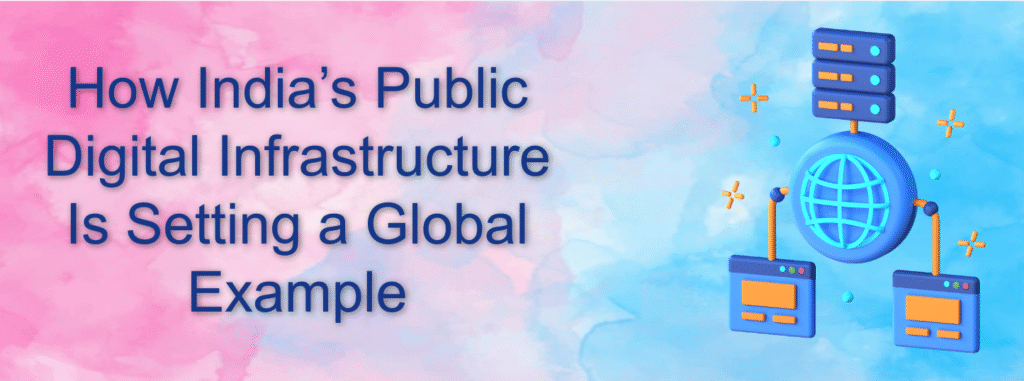How India’s Public Digital Infrastructure Is Setting a Global Example

India’s digital transformation is not just remarkable—it’s revolutionary. Over the last decade, India has built one of the world’s most inclusive and impactful digital public infrastructures (DPI), setting a benchmark for developing and developed countries alike.
From Aadhaar (the world’s largest biometric identity system) to UPI (the world’s fastest-growing real-time payments platform) to the newly introduced ONDC (Open Network for Digital Commerce), India’s public digital ecosystem is reshaping access to finance, identity, healthcare, and commerce.
This article explores how India’s DPI is driving innovation, empowering citizens, and inspiring global replication.
🇮🇳 What Is Digital Public Infrastructure (DPI)?
Digital Public Infrastructure (DPI) refers to foundational digital platforms created and maintained by governments or public institutions, designed to enable inclusive access to essential services.
India’s DPI ecosystem is built on three main layers, often referred to as the India Stack:
- Identity Layer – Aadhaar
- Payments Layer – UPI, AePS
- Data Sharing Layer – Account Aggregator Framework, DigiLocker
These are supported by platforms like:
- e-Sign, for secure digital signatures
- DigiLocker, for cloud-based document storage
- ONDC, for democratizing digital commerce
- CoWIN, for public health management (COVID-19 vaccination)
Key Components of India’s DPI
1. Aadhaar – The Identity Backbone
- World’s largest biometric ID system with over 1.3 billion users
- Enables e-KYC (Know Your Customer) in seconds
- Reduces fraud and increases service efficiency in banking, subsidies, and telecom
2. UPI – Unified Payments Interface
- Real-time, 24×7 instant payments system
- Over 10 billion transactions per month (2025)
- Accepted by street vendors, e-commerce giants, and even international merchants
UPI allows seamless money transfer with just a mobile number or UPI ID—no bank details required.
3. DigiLocker
- Government-backed digital locker to store driver’s licenses, academic certificates, PAN cards, etc.
- Used by over 180 million people for hassle-free digital document verification
4. Account Aggregator Framework
- Allows individuals to share their financial data securely and with consent
- Enables instant loan approvals, investment analysis, and credit scoring
5. ONDC – Open Network for Digital Commerce
- Government-backed initiative to break e-commerce monopolies
- Allows kirana stores, local brands, and MSMEs to participate in digital commerce with ease
- Ensures interoperability—just like UPI did for banks
Global Recognition and Adoption
India’s DPI model has caught the attention of:
- World Bank
- G20 Digital Economy Working Group
- Bill & Melinda Gates Foundation
- Several countries exploring India Stack for replication (e.g., Philippines, Ethiopia, Morocco)
In fact, India is now helping build digital public goods (DPGs) under initiatives like the Modular Open Source Identity Platform (MOSIP) and the Digital Public Infrastructure Alliance.
Financial Inclusion at Scale
Before DPI:
- 50%+ of Indians had no bank account
- Identity verification took days or weeks
- Cash-based systems dominated
After DPI:
- Over 500 million Jan Dhan accounts
- Aadhaar-enabled DBT (Direct Benefit Transfer) saves billions in leakage
- UPI brings everyone from tea sellers to entrepreneurs into the digital economy
Result: World’s largest financial inclusion effort at near-zero marginal cost.
DPI in Governance and Public Services
1. CoWIN Platform
- Digitally managed world’s largest vaccination drive
- Issued over 2 billion digital certificates
- Transparent tracking of vaccination, real-time availability of slots
2. E-RUPI
- Prepaid digital vouchers issued for specific health or education services
- Used by both public schemes and private companies
3. Aadhaar-enabled PDS (Public Distribution System)
- Ensures only genuine beneficiaries get subsidized food grains
- Reduced fraud in ration card usage across states
Enabling MSMEs and Small Merchants
DPI is leveling the playing field:
- QR-based payments via UPI for micro-merchants
- GSTN integration helps MSMEs comply with tax digitally
- ONDC offers a chance to compete with Amazon, Flipkart, and other dominant players
Small businesses now get:
- Easier access to credit
- Exposure to online marketplaces
- Tools for digital inventory and billing
DPI and Social Impact
1. Empowering Women
- Jan Dhan + Aadhaar + Mobile = JAM Trinity
- Direct transfers to women’s accounts improve household agency
- Female entrepreneurship aided by DPI-backed microcredit
2. Rural Connectivity
- DPI is language-agnostic and mobile-first
- UPI works on feature phones via UPI 123PAY
- Aadhaar-enabled services are available in rural CSCs (Common Service Centers)
3. Education and Health Access
- DigiLocker hosts academic certificates and mark sheets
- CoWIN and NDHM (National Digital Health Mission) ensure digitized health records
Challenges in DPI Implementation
While the model is powerful, some challenges remain:
- Privacy concerns: Data protection frameworks still evolving
- Digital literacy: Rural populations need more training
- Cybersecurity: Increased risk of fraud and identity theft
- Interoperability: Making all apps, platforms, and services work together smoothly
India’s Digital Personal Data Protection Act (2023) is a major step in addressing some of these concerns.
DPI and Economic Growth
India’s DPI enables:
- New business models in fintech, edtech, insurtech, agritech
- Startups like Razorpay, BharatPe, PhonePe, and Groww to scale rapidly
- Reduces bureaucratic red tape for entrepreneurs
According to a 2023 World Bank report, DPI could add up to $800 billion to India’s GDP by 2030.
Final Thoughts
India’s public digital infrastructure is more than just technology—it’s a people-first digital revolution.
By building inclusive, low-cost, scalable systems that empower citizens, India is setting an example for how nations can bridge the digital divide without depending on private monopolies.
As the world looks for models of digital sovereignty, financial inclusion, and open ecosystems, India stands tall—with DPI as its blueprint.

